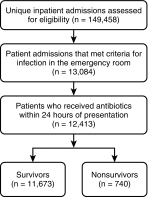Identifying Novel Sepsis Subphenotypes Using Temperature Trajectories
- PMID: 30789749
- PMCID: PMC6680307
- DOI: 10.1164/rccm.201806-1197OC
Identifying Novel Sepsis Subphenotypes Using Temperature Trajectories
Abstract
Rationale: Sepsis is a heterogeneous syndrome, and identifying clinically relevant subphenotypes is essential.Objectives: To identify novel subphenotypes in hospitalized patients with infection using longitudinal temperature trajectories.Methods: In the model development cohort, inpatient admissions meeting criteria for infection in the emergency department and receiving antibiotics within 24 hours of presentation were included. Temperature measurements within the first 72 hours were compared between survivors and nonsurvivors. Group-based trajectory modeling was performed to identify temperature trajectory groups, and patient characteristics and outcomes were compared between the groups. The model was then externally validated at a second hospital using the same inclusion criteria.Measurements and Main Results: A total of 12,413 admissions were included in the development cohort, and 19,053 were included in the validation cohort. In the development cohort, four temperature trajectory groups were identified: "hyperthermic, slow resolvers" (n = 1,855; 14.9% of the cohort); "hyperthermic, fast resolvers" (n = 2,877; 23.2%); "normothermic" (n = 4,067; 32.8%); and "hypothermic" (n = 3,614; 29.1%). The hypothermic subjects were the oldest and had the most comorbidities, the lowest levels of inflammatory markers, and the highest in-hospital mortality rate (9.5%). The hyperthermic, slow resolvers were the youngest and had the fewest comorbidities, the highest levels of inflammatory markers, and a mortality rate of 5.1%. The hyperthermic, fast resolvers had the lowest mortality rate (2.9%). Similar trajectory groups, patient characteristics, and outcomes were found in the validation cohort.Conclusions: We identified and validated four novel subphenotypes of patients with infection, with significant variability in inflammatory markers and outcomes.
Keywords: group-based trajectory modeling; infection; sepsis; temperature.
Figures



Comment in
-
Identifying Sepsis Subtypes from Routine Clinical Data.Am J Respir Crit Care Med. 2019 Aug 1;200(3):272-273. doi: 10.1164/rccm.201903-0532ED. Am J Respir Crit Care Med. 2019. PMID: 30848936 Free PMC article. No abstract available.
-
Reply to Leijte et al.: Fever in Sepsis: Still a Hot Topic.Am J Respir Crit Care Med. 2019 Jul 15;200(2):264-265. doi: 10.1164/rccm.201903-0631LE. Am J Respir Crit Care Med. 2019. PMID: 30908923 Free PMC article. No abstract available.
-
Fever in Sepsis: Still a Hot Topic.Am J Respir Crit Care Med. 2019 Jul 15;200(2):263-264. doi: 10.1164/rccm.201903-0484LE. Am J Respir Crit Care Med. 2019. PMID: 30908926 Free PMC article. No abstract available.
-
Adherence to the Prevailing Sepsis Definition Is Quintessential to Subphenotype Identification.Am J Respir Crit Care Med. 2020 Jan 15;201(2):258. doi: 10.1164/rccm.201908-1525LE. Am J Respir Crit Care Med. 2020. PMID: 31517501 Free PMC article. No abstract available.
-
Reply to Maitra and Bhattacharjee: Adherence to the Prevailing Sepsis Definition Is Quintessential to Subphenotype Identification.Am J Respir Crit Care Med. 2020 Jan 15;201(2):258-259. doi: 10.1164/rccm.201908-1619LE. Am J Respir Crit Care Med. 2020. PMID: 31517504 Free PMC article. No abstract available.
References
-
- Mullard A. Drug withdrawal sends critical care specialists back to basics. Lancet. 2011;378:1769. - PubMed
-
- Angus DC. The search for effective therapy for sepsis: back to the drawing board? JAMA. 2011;306:2614–2615. - PubMed
-
- Cohen J, Opal S, Calandra T. Sepsis studies need new direction. Lancet Infect Dis. 2012;12:503–505. - PubMed
-
- Cohen J, Vincent JL, Adhikari NK, Machado FR, Angus DC, Calandra T, et al. Sepsis: a roadmap for future research. Lancet Infect Dis. 2015;15:581–614. - PubMed
Publication types
MeSH terms
Grants and funding
LinkOut - more resources
Full Text Sources
Medical

